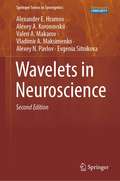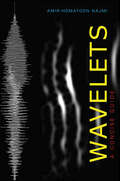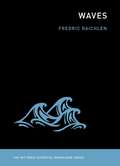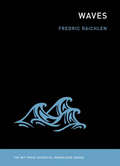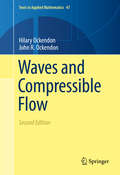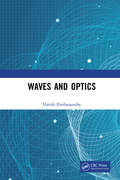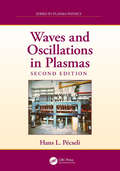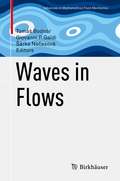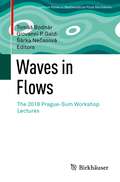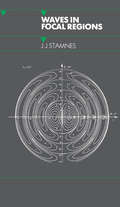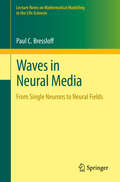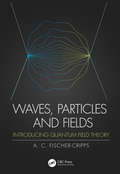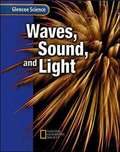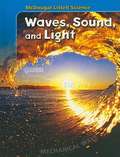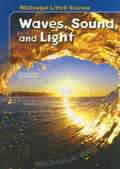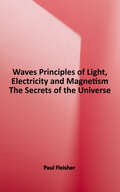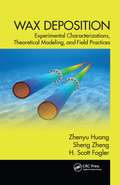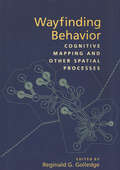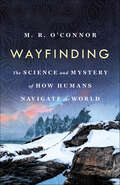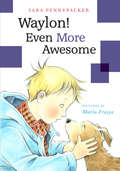- Table View
- List View
Wavelets in Neuroscience (Springer Series in Synergetics)
by Alexander E. Hramov Alexey A. Koronovskii Valeri A. Makarov Alexey N. Pavlov Evgenia Sitnikova Vladimir A. MaksimenkoThis book illustrates how modern mathematical wavelet transform techniques offer fresh insights into the complex behavior of neural systems at different levels: from the microscopic dynamics of individual cells to the macroscopic behavior of large neural networks. It also demonstrates how and where wavelet-based mathematical tools can provide an advantage over classical approaches used in neuroscience. The authors well describe single neuron and populational neural recordings.This 2nd edition discusses novel areas and significant advances resulting from experimental techniques and computational approaches developed since 2015, and includes three new topics:• Detection of fEPSPs in multielectrode LFPs recordings.• Analysis of Visual Sensory Processing in the Brain and BCI for Human Attention Control;• Analysis and Real-time Classification of Motor-related EEG Patterns;The book is a valuable resource for neurophysiologists and physicists familiar with nonlinear dynamical systems and data processing, as well as for graduate students specializing in these and related areas.
Wavelets: A Concise Guide
by Amir-Homayoon NajmiIntroduced nearly three decades ago as a variable resolution alternative to the Fourier transform, a wavelet is a short oscillatory waveform for analysis of transients. The discrete wavelet transform has remarkable multi-resolution and energy-compaction properties. Amir-Homayoon Najmi’s introduction to wavelet theory explains this mathematical concept clearly and succinctly. Wavelets are used in processing digital signals and imagery from myriad sources. They form the backbone of the JPEG2000 compression standard, and the Federal Bureau of Investigation uses biorthogonal wavelets to compress and store its vast database of fingerprints. Najmi provides the mathematics that demonstrate how wavelets work, describes how to construct them, and discusses their importance as a tool to investigate and process signals and imagery. He reviews key concepts such as frames, localizing transforms, orthogonal and biorthogonal bases, and multi-resolution. His examples include the Haar, the Shannon, and the Daubechies families of orthogonal and biorthogonal wavelets.Our capacity and need for collecting and transmitting digital data is increasing at an astonishing rate. So too is the importance of wavelets to anyone working with and analyzing digital data. Najmi’s primer will be an indispensable resource for those in computer science, the physical sciences, applied mathematics, and engineering who wish to obtain an in-depth understanding and working knowledge of this fascinating and evolving field.
Waves
by Fredric RaichlenSitting on the beach on a sunny summer day, we enjoy the steady advance and retreat of the waves. In the water, enthusiastic waders jump and shriek with pleasure when a wave hits them. But where do these waves come from? How are they formed and why do they break on the shore? In Waves, Fredric Raichlen traces the evolution of waves, from their generation in the deep ocean to their effects on the coast. He explains, in a way that is readily understandable to nonscientists, both the science of waves themselves and the technology that can be used to protect us against their more extreme forms, including hurricanes and tsunamis. After offering a basic definition of waves and explaining the mechanics of wind-wave generation, Raichlen describes how waves travel, how they shoal (rise), how they break, and how they transform in other ways. He goes on to describe, among other things, the complicated sun-Earth-moon combinations that create astronomical tides (the high and low tides that occur daily and predictably); the effects of waves on the beach, including rip currents and beach erosion, and on harbors and shipping; and the building of breakwaters to protect harbors and bays. He discusses hurricanes, storm surges, and hurricane-generated waves. He offers a brief history of tsunamis, including Sumatra's in 2004 and Japan's in 2011, and explains the mechanisms that generate them (including earthquakes, landslides, and volcanoes). Waves can be little ripples that lap peacefully at the shore or monstrous tsunamis that destroy everything in their paths. Describing the science underlying this astonishing variety, Waves offers a different kind of beach reading.
Waves & Their Applications, Module L (HMH Science Dimensions)
by Marjorie Frank Michael Heithaus Michael DiSpezioNIMAC-sourced textbook
Waves (The MIT Press Essential Knowledge series)
by Fredric RaichlenA guide to ocean waves traces their evolution from wind-wave generation to coastal effects. Sitting on the beach on a sunny summer day, we enjoy the steady advance and retreat of the waves. In the water, enthusiastic waders jump and shriek with pleasure when a wave hits them. But where do these waves come from? How are they formed and why do they break on the shore? In Waves, Fredric Raichlen traces the evolution of waves, from their generation in the deep ocean to their effects on the coast. He explains, in a way that is readily understandable to nonscientists, both the science of waves themselves and the technology that can be used to protect us against their more extreme forms, including hurricanes and tsunamis.After offering a basic definition of waves and explaining the mechanics of wind-wave generation, Raichlen describes how waves travel, how they shoal (rise), how they break, and how they transform in other ways. He goes on to describe, among other things, the complicated sun-Earth-moon combinations that create astronomical tides (the high and low tides that occur daily and predictably); the effects of waves on the beach, including rip currents and beach erosion, and on harbors and shipping; and the building of breakwaters to protect harbors and bays. He discusses hurricanes, storm surges, and hurricane-generated waves. He offers a brief history of tsunamis, including Sumatra's in 2004 and Japan's in 2011, and explains the mechanisms that generate them (including earthquakes, landslides, and volcanoes).Waves can be little ripples that lap peacefully at the shore or monstrous tsunamis that destroy everything in their paths. Describing the science underlying this astonishing variety, Waves offers a different kind of beach reading.
Waves and Compressible Flow
by Hilary Ockendon John R. OckendonNow in its second edition, this book continues to give readers a broad mathematical basis for modelling and understanding the wide range of wave phenomena encountered in modern applications. New and expanded material includes topics such as elastoplastic waves and waves in plasmas, as well as new exercises. Comprehensive collections of models are used to illustrate the underpinning mathematical methodologies, which include the basic ideas of the relevant partial differential equations, characteristics, ray theory, asymptotic analysis, dispersion, shock waves, and weak solutions. Although the main focus is on compressible fluid flow, the authors show how intimately gasdynamic waves are related to wave phenomena in many other areas of physical science. Special emphasis is placed on the development of physical intuition to supplement and reinforce analytical thinking. Each chapter includes a complete set of carefully prepared exercises, making this a suitable textbook for students in applied mathematics, engineering, and other physical sciences. Reviews of the first edition: "This book . . . is an introduction to the theory of linear and nonlinear waves in fluids, including the theory of shock waves. . . . is extraordinarily accurate and free of misprints . . . . I enjoyed reading this book. . . . most attractive and enticing appearance, and I'm certain that many readers who browse through it will wish to buy a copy. The exercises . . . are excellent. . . . A beginner who worked through these exercises would not only enjoy himself or herself, but would rapidly acquire mastery of techniques used. . . in JFM and many other journals. . . " (C. J. Chapman, Journal of Fluid Mechanics, Vol. 521, 2004) "The book targets a readership of final year undergraduates and first year graduates in applied mathematics. In the reviewer's opinion, it is very well designed to catch the student's interest . . . while every chapter displays essential features in some important area of fluid dynamics. Additionally, students may practice by solving 91 exercises. This volume is mainly devoted to inviscid flows. . . . The book is very well written. " (Denis Serre, Mathematical Reviews, 2004)
Waves and Optics
by Harish ParthasarathyThis book covers all aspects of waves and optics ranging from one dimensional waves in a vibrating string, two dimensional waves in a vibrating membrane, both of which are transverse, three dimensional electromagneticwaves generated by radiating antennas and longitudinal sound/pressure waves in an air column. Note: T&F does not sell or distribute the Hardback in India, Pakistan, Nepal, Bhutan, Bangladesh and Sri Lanka.
Waves and Oscillations in Plasmas (Series in Plasma Physics)
by Hans L. PecseliWaves and Oscillations in Plasmas addresses central issues in modern plasma sciences, within the context of general classical physics. The book is working gradually from an introductory to an advanced level. Addressing central issues in modern plasma sciences, including linear and nonlinear wave phenomena, this second edition has been fully updated and includes the latest developments in relevant fluid models as well as kinetic plasma models, including a detailed discussion of, for instance, collisionless Landau damping, linear as well as non-linear. The book is the result of many years of lecturing plasma sciences in Norway, Denmark, Germany, and also at the Unites States of America. Offering a clear separation of linear and nonlinear models, the book can be tailored for students of varying levels of expertise in plasma physics, in addition to areas as diverse as the space sciences, laboratory experiments, plasma processing, and more. Features: Presents a simple physical interpretation of basic problems is presented where possible Supplies a complete summary of classical papers and textbooks placed in the proper context Includes worked examples, exercises, and problems with general applicability
Waves in Flows (Advances in Mathematical Fluid Mechanics)
by Giovanni P. Galdi Tomáš Bodnár Šárka NečasováThis volume offers an overview of the area of waves in fluids and the role they play in the mathematical analysis and numerical simulation of fluid flows. Based on lectures given at the summer school “Waves in Flows”, held in Prague from August 27-31, 2018, chapters are written by renowned experts in their respective fields. Featuring an accessible and flexible presentation, readers will be motivated to broaden their perspectives on the interconnectedness of mathematics and physics. A wide range of topics are presented, working from mathematical modelling to environmental, biomedical, and industrial applications. Specific topics covered include:Equatorial wave–current interactionsWater–wave problemsGravity wave propagationFlow–acoustic interactions Waves in Flows will appeal to graduate students and researchers in both mathematics and physics. Because of the applications presented, it will also be of interest to engineers working on environmental and industrial issues.
Waves in Flows: The 2018 Prague-Sum Workshop Lectures (Advances in Mathematical Fluid Mechanics)
by Giovanni P. Galdi Tomáš Bodnár Šárka NečasováThis volume explores a range of recent advances in mathematical fluid mechanics, covering theoretical topics and numerical methods. Chapters are based on the lectures given at a workshop in the summer school Waves in Flows, held in Prague from August 27-31, 2018. A broad overview of cutting edge research is presented, with a focus on mathematical modeling and numerical simulations. Readers will find a thorough analysis of numerous state-of-the-art developments presented by leading experts in their respective fields. Specific topics covered include:ChemorepulsionCompressible Navier-Stokes systemsNewtonian fluidsFluid-structure interactions Waves in Flows: The 2018 Prague-Sum Workshop Lectures will appeal to post-doctoral students and scientists whose work involves fluid mechanics.
Waves in Focal Regions: Propagation, Diffraction and Focusing of Light, Sound and Water Waves
by J.J StamnesUsing numerous mathematical and numerical techniques of diffraction theory, Waves in Focal Regions: Propagation, Diffraction and Focusing of Light, Sound and Water Waves provides a full and richly illustrated description of waves in focal regions. Unlike most books, the author treats electromagnetic, acoustic, and water waves in one comprehensive volume. After an introductory section, the book describes approximate diffraction theories and efficient numerical methods to study the focusing of various kinds of waves. It then covers the physical interpretation of the theories, their accuracy, and the computational savings obtained, emphasizing uniform asymptotic results that remain valid in the vicinity of shadow boundaries and caustics. The next part deals with the focusing of scalar waves, including thorough theoretical analyses and detailed contour maps of diffraction patterns in focal regions for a variety of different system parameters, such as f-number, Frensel number, aperture shape, amplitude distribution, and wavefront aberration. The author proceeds to explore the diffraction and focusing of electromagnetic waves. First solutions are derived for fields radiated by sources, reflected and refracted at plane interfaces, or diffracted by apertures in plane screens, and then these solutions are applied to study the focusing in homogeneous media and through a plane dielectric interface. In both cases, the author includes many computed results of the electromagnetic field distribution near focus. Presenting both theoretical and experimental results, the following part examines the focusing of sound and water waves by means of zone-plate lenses. The book concludes with a detailed study of the diffraction and focusing of water waves and a comparison of the results of both linear and nonlinear theories with those of experiments.
Waves in Neural Media
by Paul C. BressloffWaves in Neural Media: From Single Neurons to Neural Fields surveys mathematical models of traveling waves in the brain, ranging from intracellular waves in single neurons to waves of activity in large-scale brain networks. The work provides a pedagogical account of analytical methods for finding traveling wave solutions of the variety of nonlinear differential equations that arise in such models. These include regular and singular perturbation methods, weakly nonlinear analysis, Evans functions and wave stability, homogenization theory and averaging, and stochastic processes. Also covered in the text are exact methods of solution where applicable. Historically speaking, the propagation of action potentials has inspired new mathematics, particularly with regard to the PDE theory of waves in excitable media. More recently, continuum neural field models of large-scale brain networks have generated a new set of interesting mathematical questions with regard to the solution of nonlocal integro-differential equations. Advanced graduates, postdoctoral researchers and faculty working in mathematical biology, theoretical neuroscience, or applied nonlinear dynamics will find this book to be a valuable resource. The main prerequisites are an introductory graduate course on ordinary differential equations or partial differential equations, making this an accessible and unique contribution to the field of mathematical biology.
Waves in Oceanic and Coastal Waters
by Leo H. HolthuijsenWaves in Oceanic and Coastal Waters describes the observation, analysis and prediction of wind-generated waves in the open ocean, in shelf seas, and in coastal regions with islands, channels, tidal flats and inlets, estuaries, fjords and lagoons. Most of this richly illustrated book is devoted to the physical aspects of waves. After introducing observation techniques for waves, both at sea and from space, the book defines the parameters that characterise waves. Using basic statistical and physical concepts, the author discusses the prediction of waves in oceanic and coastal waters, first in terms of generalised observations, and then in terms of the more theoretical framework of the spectral energy balance. He gives the results of established theories and also the direction in which research is developing. The book ends with a description of SWAN (Simulating Waves Nearshore), the preferred computer model of the engineering community for predicting waves in coastal waters.
Waves in an Impossible Sea: How Everyday Life Emerges from the Cosmic Ocean
by Matt StrasslerA theoretical physicist takes readers on an awe-inspiring journey—found in "no other book" (Science)—to discover how the universe generates everything from nothing at all: "If you want to know what's really going on in the realms of relativity and particle physics, read this book" (Sean Carroll, author of The Biggest Ideas in the Universe). In Waves in an Impossible Sea, physicist Matt Strassler tells a startling tale of elementary particles, human experience, and empty space. He begins with a simple mystery of motion. When we drive at highway speeds with the windows down, the wind beats against our faces. Yet our planet hurtles through the cosmos at 150 miles per second, and we feel nothing of it. How can our voyage be so tranquil when, as Einstein discovered, matter warps space, and space deflects matter? The answer, Strassler reveals, is that empty space is a sea, albeit a paradoxically strange one. Much like water and air, it ripples in various ways, and we ourselves, made from its ripples, can move through space as effortlessly as waves crossing an ocean. Deftly weaving together daily experience and fundamental physics—the musical universe, the enigmatic quantum, cosmic fields, and the Higgs boson—Strassler shows us how all things, familiar and unfamiliar, emerge from what seems like nothing at all. Accessible and profound, Waves in an Impossible Sea is the ultimate guide to our place in the universe.
Waves, Energy and Information: Investigating How Dolphins Communicate, Investigation Notebook
by The Lawrence Hall of ScienceNIMAC-sourced textbook
Waves, Particles and Fields: Introducing Quantum Field Theory
by Anthony C. Fischer-CrippsChoice Outstanding Title, September 2020This book fills a gap in the middle ground between quantum mechanics of a single electron to the concept of a quantum field. In doing so, the book is divided into two parts; the first provides the necessary background to quantum theory extending from Planck’s formulation of black body radiation to Schrodinger’s equation; and the second part explores Dirac’s relativistic electron to quantum fields, finishing with an description of Feynman diagrams and their meaning. Much more than a popular account, yet not too heavy so as to be inaccessible, this book assumes no prior knowledge of quantum physics or field theory and provides the necessary foundations for readers to then progress to more advanced texts on quantum field theory. It will be of interest to undergraduate students in physics and mathematics, in addition to an interested, general audience.Features: Provides an extensive yet accessible background to the concepts Contains numerous, illustrative diagrams Presents in-depth explanations of difficult subjects
Waves, Sound, and Light
by Glencoe Mcgraw-HillDiscover the Flexibility to Teach Science Your Way!. "Glencoe Science: Waves, Sound, and Light," a module in the Glencoe Science 15 book series, provides students with accurate and comprehensive coverage of middle school National Science Education Standards. Concepts are explained in a clear, concise manner, and are integrated with a wide range of hands-on experiences, critical thinking opportunities, real-world applications, and connections to other sciences and to non-science areas of the curriculum. Co-authored by National Geographic, unparalleled graphics reinforce key concepts. A broad array of print and technology resources help differentiate and accommodate all learners. The modular approach allows you to mix and match books to meet your specific curriculum needs.
Waves, Sound, and Light
by Mcdougal-Littell StaffEach chapter in Waves, Sound, and Light covers some of the learning goals that are described in the National Science Education Standards (NSES) and the Project 2061 Benchmarks for Science Literacy.
Waves: Principles of Light, Electricity and Magnetism (Secrets of the Universe)
by Paul FleisherHave you ever wondered why a prism turns ordinary sunlight into a rainbow? Isaac Newton knew why. How can a magnet be used to generate electricity? Michael Faraday could have told you. Can you explain how a toaster toasts bread? In this book, author Paul Fleisher answers these and many more questions as he looks at the laws that describe how waves behave. Through simple experiments, detailed illustrations, and concepts that are easy to understand, readers are introduced to the basic principles of light, electricity, and magnetism in a fun, exciting way.
Wax Deposition: Experimental Characterizations, Theoretical Modeling, and Field Practices (Emerging Trends And Technologies In Petroleum Engineering Ser.)
by Zhenyu HuangWax Deposition: Experimental Characterizations, Theoretical Modeling, and Field Practices covers the entire spectrum of knowledge on wax deposition. The book delivers a detailed description of the thermodynamic and transport theories for wax deposition modeling as well as a comprehensive review of laboratory testing for the establishment of appropr
Wayfinding Behavior: Cognitive Mapping and Other Spatial Processes
by Reginald G. GolledgeThe metaphor of a "cognitive map"has attracted wide interest since it was first proposed in the late 1940s. Researchers from fields as diverse as psychology, geography, and urban planning have explored how humans process and use spatial information, often with the view of explaining why people make wayfinding errors or what makes one person a better navigator than another. Cognitive psychologists have broken navigation down into its component steps and shown it to be an interplay of neurocognitive functions, such as "spatial updating"and "reference frames"or "perception-action couplings."But there has also been an intense debate among biologists over whether animals have cognitive maps or have other forms of internal spatial representations that allow them to behave as if they did. Yet until now, little has been done to relate research on human and non-human subjects in this area.In Wayfinding Behavior: Cognitive Mapping and Other Spatial Processes Reginald Golledge brings together a distinguished group of scholars to offer a unique and comprehensive survey of current research in these diverse fields. Among the common themes they discover is the psychologists' "black box"approach, in which the internal mechanisms of spatial perception and route planning are modeled or constructed, like metaphors, based on the behavioral evidence. Cognitive neuroscientists, on the other hand, have attempted to discover the neurocognitive basis for spatial behavior. (They have shown, for example, that damage in the hippocampus system invariably impairs the ability of animals and humans to learn about, remember, and navigate through environments, and studies in humans show that neurons in this system code for location, direction, and distance, thereby providing the elements needed for a mapping system.) Artificial intelligence and robotics theorists attempt to construct intelligent mapping systems using computer technology. In these areas, there is growing evidence that, as in human wayfinding processes, useful representations cannot be achieved without sacrificing completeness and precision.Wayfinding Behavior: Cognitive Mapping and Other Spatial Processes offers not only state-of-the-art knowledge about "wayfinding, "but also represents a point of departure for future interdisciplinary studies. "The more we know," concludes volume editor Reginald Golledge, "about how humans or other species can navigate, wayfind, sense, record and use spatial information, the more effective will be the building of future guidance systems, and the more natural it will be for human beings to understand and control those systems."
Wayfinding: The Science and Mystery of How Humans Navigate the World
by M. R. O'ConnorAt once far flung and intimate, a fascinating look at how finding our way make us human."A marvel of storytelling." —Kirkus (Starred Review) In this compelling narrative, O'Connor seeks out neuroscientists, anthropologists and master navigators to understand how navigation ultimately gave us our humanity. Biologists have been trying to solve the mystery of how organisms have the ability to migrate and orient with such precision—especially since our own adventurous ancestors spread across the world without maps or instruments. O'Connor goes to the Arctic, the Australian bush and the South Pacific to talk to masters of their environment who seek to preserve their traditions at a time when anyone can use a GPS to navigate. O’Connor explores the neurological basis of spatial orientation within the hippocampus. Without it, people inhabit a dream state, becoming amnesiacs incapable of finding their way, recalling the past, or imagining the future. Studies have shown that the more we exercise our cognitive mapping skills, the greater the grey matter and health of our hippocampus. O'Connor talks to scientists studying how atrophy in the hippocampus is associated with afflictions such as impaired memory, dementia, Alzheimer’s Disease, depression and PTSD. Wayfinding is a captivating book that charts how our species' profound capacity for exploration, memory and storytelling results in topophilia, the love of place."O'Connor talked to just the right people in just the right places, and her narrative is a marvel of storytelling on its own merits, erudite but lightly worn. There are many reasons why people should make efforts to improve their geographical literacy, and O'Connor hits on many in this excellent book—devouring it makes for a good start." —Kirkus Reviews
Waylon! Even More Awesome: Even More Awesome (Waylon #2)
by Sara PennypackerWaylon thinks most problems can be solved with science. But when it comes to having to share a dog with Baxter Boylen, science may not be very helpful. Baxter is the closest thing to a juvenile delinquent Waylon has ever met. He's always getting called to Principal Rice's office, and now he's even having meetings with the chief of police. At least the two boys can visit their dog, Dumpster Eddy, while they're at the station. Eddy is behind bars in the Stray Animals' Lock-up. When a new Animal Control officer takes over, it looks as though the dog's days are numbered. Waylon comes up with a science-y plan to save Eddy, but can he trust Baxter to help him carry it out?
